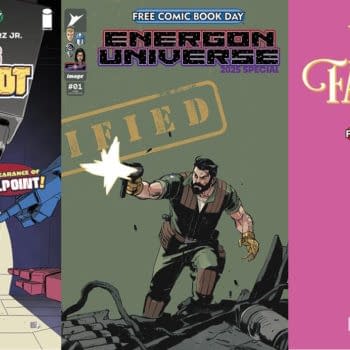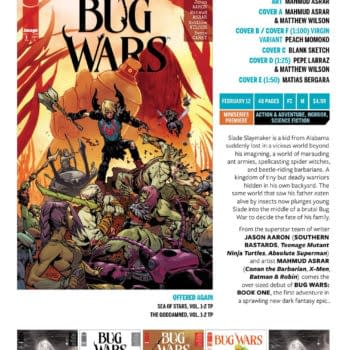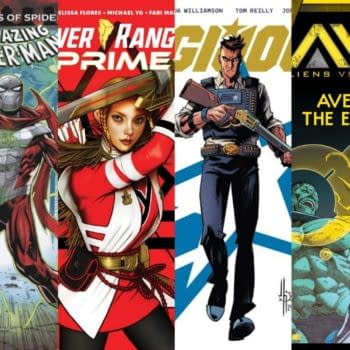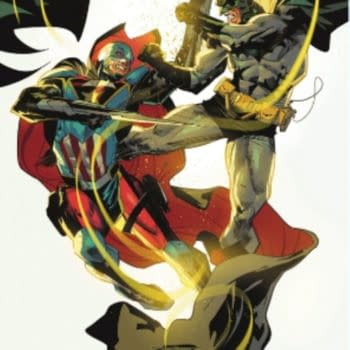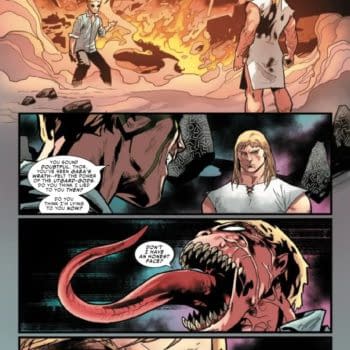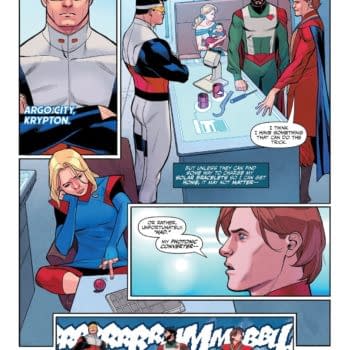Posted in: Comics | Tagged: Comics, entertainment
"Everything Is An Advert For Everything Else" – Tom Scioli Talks Transformers Vs. GI Joe And Young Animal's Super Powers
Tom Scioli is the writer and artist (along with co-writer John Barber) of IDW's pre-Revolution crossover comic Transformers vs. GI Joe. The project spanned from #0, the company's Free Comic Book Day offering of 2014, to the oversized #13. Its third, and final, collected edition shipped in August.
The comic features a self-contained story dealing with the classic characters of both franchises coming together to deal with threats old and new with a look very much inspired by Jack Kirby. Almost every major (and some surprising minor) characters from previous cartoons, comics, and films make an appearance. The series' big finale leaves the characters in a place that is new and original, for both brands, but leaves the door open for future stories in this imaginative world.
Bleeding Cool spoke with the Pittsburgh native about what went into making the comic, as well as his creator owned work (most of which is available in its entirety at http://www.ambarb.com/), and what to expect from his upcoming Super Powers back-up stories to appear in Cave Carson has a Cybernetic Eye from DC's Young Animal imprint (on sale beginning this month).
Consider this your spoiler warning for any work discussed.
Bleeding Cool: Reading Transformers vs. GI Joe, as well as some of your other work, it occurred to me that you seem to be a Grant Morrison fan [Note: Among other references issue #4 features the We3 inspired US7, a team comprised of G.I. Joe animal sidekicks). Considering how dense his work can be what did you take from it while working with these licensed properties?
Tom Scioli: There are definite time jumps where you turn the page and it's obvious that you missed a lot of stuff. That's a technique that I take from him. I probably saw that in a Robert Kirkman comic before I even saw that in a Grant Morrison comic. The thing of Morrison's that really made me a fan of his was All-Star Superman, that really classicist approach where you tell a story as completely as possible and make each individual issue its own statement and still have it be part of a larger continuum. There is also the idea of cherry-picking the best, or most-interesting ideas, those rife with the most possibility, within every iteration of what you are working on.
BC: I believe Morrison called it 'channel-zapping' when he was discussing Final Crisis and I see that with TVG. During the first read through there might be that sense that I am missing something but it does not prevent me from enjoying the book and only adds to the dense feel of the material. That second or third time through I'm noticing the things we're not shown and your imagination kind of gets to run wild with the possibilities.
TS: Final Crisis is something I have read a bunch of times and at first I was not sure about it but the last time I read it I realized how influential it was on what I was doing. FC tells a complete story but it is not the story of just one character, it is more like a relay race with different heroes taking up the baton. I'm not necessarily interested in a story where everyone is fighting the major villain at once.
It is usually just a few quick panels and then it's done. With FC the death of Darkseid is the death of a thousand blows. Batman shoots him with the gun which begins the death, the Black Racer crashes into him, and even then it takes that much to destroy someone that evil. They take him apart a piece at a time leaving only the idea, or the ghost, of Darkseid. Even then a stake has to be driven into it.
This was on my mind as I crafted the final battle with Megatron. You're telling this story with a million characters, if a bunch do not play a role in the destruction of this villain then why were they there in the first place? This was also an opportunity to comment on a few of the things I didn't necessarily like about FC. I learn so much from creators' strengths, what they do well, but also what didn't quite work and asking how can you make that thing work.
BC: Going back to the final battle with Megatron, with Transformers it always seems as if Optimus Prime, or whoever the leader is at that time, is the one who has to stop him and that the other characters are, or become, inconsequential. Whoever the most popular toy is supposed to be. Here though everyone has a role. How were you able to make those characters, some with only one or two appearances in any medium in the past, into someone the reader could care about?
TS: It was really a side effect of the research process. Going into this I was not confident of my knowledge of Transformers and G.I. Joe. It's not as if I came into this as a superfan with an encyclopedic understanding and I needed to do my homework. Reading the comics and watching the shows and noting more minor characters then wishing I had known about some of them sooner but better late than never. I made the decision early on that there are a bunch of ways to do this comic and one way is to focus on the core characters, the 'Fantastic Four' of the Transformers or G.I. Joe. I decided that there is too deep of a roster to just focus on Snake-Eyes or Duke, it would be a missed opportunity. I could have gone either way but decided to go deep and, of course, those characters ended up playing major roles. If I could do this all over again it would be interesting to see what would happen if I went the other way, and really deep, with a handful of characters.
BC: This is in contrast to the way the story has been presented when these characters have met in the past. You might have Optimus Prime and Snake-Eyes deal with the threat while others, not on that level, are relegated to cameos. Coming to the work as a fan of the properties even I had to do a little more research into characters that I was not overly familiar with such as Brawn or Dr. Venom. Characters who sometimes don't even have a toy.
TS: When Morrison did Seven Soldiers that was early in the history of online blogging and social media and he wasn't going to worry about a character being too obscure or a story element that is not illustrated explicitly because there was this active community that discussed these things, took them apart, and if you have questions about the work you'll be able to find the answers. I took that to heart and that is one of the roles the backmatter served [Note: Each issue of TVG features an in-depth discussion between Scioli and co-writer John Barber that highlights the issue's themes and some of what was left on the cutting-room floor].
BC: The backmatter was sometimes my favorite part of reading this because not only did it offer a window into the process but it served the highlight some of the weird, rewarding aspects of the comic. Issue 4 has the first appearance of Optimus Prime but it is in an unrecognizable form which you explained as the ideal form for where he was, stuck between dimensions. The idea that Transformers could become what they needed to be made me want to take a second look at what I had already read. Why was the decision made to have the commentary present? I cannot think of many other comics that have it.
TS: I'm a very analytical creator. I almost overthink everything, rewrite and rewrite, and take things apart. This project had a long lead time which allowed me to write pages of ideas and play with concepts before it even began. With the first issue, which was 16 pages, I had the problem of how to cram all of this in. Once I found out the size of the actual issue, in addition to the pages I was being paid to do, I knew that I wanted to get as much content in there as possible. Pinups, posters, and things that were telling the story. The commentary grew out of that. There are so many creators whose work I get more out of because I know them and I feel as if this is almost something that everyone should do. If you're just going to run ads in the back then why not put something in there where you can introduce the reader to you and what your personality is?
BC: It surprises me that we don't see more of this as it allowed you to lay out a sort of mission statement for the book. Often you would discuss characters that appeared once and what they were up to since their reappearance in the current issue and I got the feeling that there was an entire arc in between those two points. What were the mechanics of it, did you and John meet or just have a phone call?
TS: It's a little bit of comic book magic. The conceit is that we're having a conversation but really one of us would begin a commentary and then pass it to the next person to give the illusion of a conversation. It was really a digital conversation over text that we wanted to read as conversationally as possible. People so rarely sit in a room to talk about the comics anymore. Even Stan Lee and Jack Kirby eventually did it over the phone or through the mail. We did discuss moving in together, sort of like the Beatles in Help!
BC: Can you talk about working with John Barber? In the commentary he discusses how you do most of the heavy lifting but he's written Transformers in the past and I'm wondering what the breakdown in terms of work product is. Was it a bit similar to the old Marvel Method?
TS: Not Marvel Method, more like the way Dan Dare was made, this labor-intensive way of making a comic. I wanted to try this way of putting way more work into making a comic, with each of us continuously writing and getting our strongest and best ideas, and then essentially smashing them together to see that the best ideas win. In the beginning it was far more collaborative but as time went on it was easier for me to just do more and more. For the sake of time it was me working by myself. I had never really done a comic in this way, month in and month out. I had to 'keep the furnace burning' and it was intense.
BC: Toward the end, once you were on your own, did you feel yourself getting into a groove? Things in the comic appear to speed up and there is a sort of shorthand that comes into play. How were you feeling, especially as you realized the book was ending?
TS: There was a point in the middle where I felt incredibly fatigued. Larry David would talk about Seinfeld saying 'how am I going to write the first episode, I have no idea what I'm going to do!' then after that it would be 'how am I going to write the second.' It became clear that I needed an endpoint and then to work towards that. After we knew how the collected editions would work we talked about doing just one more volume and making it be this self-contained thing. I took some time to figure out what that last volume would be and once that was understood it became a joy again.
I think that's just how things are. When you begin, everything is great, but when you're in the middle it's like being in a lake. Too far from one shore but as you get closer to the other, and to that endpoint, you get more energized. It became 'why are we ending this again?' For those last few issues I stopped worrying about deadlines and focused on making it the best I could. I'm proud of everything we did but I feel as if those final few issues are among the strongest things I've done.
BC: Jumping back, you mean the Dan Dare comics from the 1950s, from Eagle?
TS: Yes. There was this book that discussed the process of making those. It was an office full of people, all working on one issue. They would build models for reference. No one puts that level of effort into making a comic, you could not imagine doing that today because comics just do not have the budget. It was almost as if you were putting on a TV show.
BC: Speaking of models did you have Transformers' toys in front of you while working on this?
TS: In the beginning, yes. There is such a learning curve to drawing Transformers and in most cases this was my first time drawing these. People were lending me their toy collections and I was sketching them. The preparation for this series was immense. I took it incredibly seriously and for the great creative opportunity that it was. Since then I am trying to do the same with everything even if it is something I feel more confident with going in. Even though I am more familiar with the characters in Super Powers I'm still using the lead time to sort of free-associate and write. I just bought a bunch of Super Friends comics from the seventies to brush up.
BC: When the series began you mentioned that TVG could go on for years. It was shocking to see issue #13 solicited as the finale. Was there a particular reason why it ended? Was it something you decided, was it sales, or did Hasbro make the decision?
TS: John had said we could do as many issues as we want. It was me. I came in with so much enthusiasm and I thought I could do this forever but as it went on I began to see the virtue of seeing the end of this amazing arc. I have ideas for further adventures but it was a question of leaving now before things ran the risk of slowing down creatively. Let it be a contained thing that I am very proud of and maybe revisit it a few years down the line.
When it was over there was this sense of 'why did I end this, this was the best job I've ever had!' but then something such as Super Powers comes along and you realize that this is why I wanted to end it because by working on something totally new all of a sudden you become reinvigorated. If you work on the same thing forever you lose enthusiasm for it. For everyone involved this was the best way to give yourself a break and maybe come back later. You do every crazy Transformers and G.I. Joe related idea you can think of and then it becomes 'I have to think of a bunch more' and it's a lot easier to do that with something totally new.
BC: Speaking of 'every crazy idea for these two properties' the scene that I feel encapsulates the entire series is the double-page spread from issue 6. You have the Lovecraftian version of Cobra-god "Koh-Buru-La" on its way in the background, while the middleground has a titanic battle between Optimus Prime and Shockwave over the body of the latter's brother's body of Soundwave, and in the foreground you have Battleforce 2000, one of the many G.I. Joe subgroups that sought to extend the lifetime of the toy franchise. It's this incredibly dense cacophony of imagery that demands you examine every inch and rewards with constant surprises drawn in every available space. Any quadrant appears to contain its own story and the reader is seeing many subplots play out together, harmoniously, but simultaneously.
If this was you taking everything from every canon and "smashing the toys together" then what was your inspiration for what you added, specifically the Celtic mythology that ties all of the factions together. Why focus on this commonality? You also focused on what happens when Transformers and humans become more like each other, culminating in Wild Bill becoming a cybertronic being.
TS: Part of this was looking past what was already in the properties and looking at the ideas themselves. What is it "to transform?" What is it to be an intelligent robot? What are G.I. Joe? They seem to be super soldiers that employ whatever science is available to them. Just looking at real life, with artificial intelligence and the 'presentshock,' it seemed as if there will come a day when you cannot tell the difference between a G.I. Joe and a Transformer.
This was something I arrived at early, as I was researching. If you take these ideas to their extremes then you have a robot who is in disguise, it can really look like anything. You begin to question what the difference is between man and machine if you can replicate on a molecular level. You see some of this in the most recent Transformers' film as well. It is an effect of that research process and you go out where you can. For the Celtic stuff I tried to go back as far as I could with all of them and then map potential family histories based on last names. Scarlett for example is Irish and when you research this and things such as Destro's Scottish ancestry you see that the line between these were so fluid and related.
BC: Going further back in the shared timeline the reader is introduced, in the final issue, to Atlas, the Earth-as-Transformer, who is activated by G.I. Joe in time to prevent Cybertron/Primus from devouring the Sun under the command of Megatron. At what point did you decide that Earth had to be able to transform and that that would be the series' climax?
TS: That was something John and I talked about from the very beginning, literally one of our first conversations. Make America the 'shield' as if the world were Captain America. I had always had this concept 'what if Unicron was Earth' and have the characters discover that Earth was Unicron this entire time. Our goal here is to make a comic where that makes perfect sense, where the Earth being a Transformer is a natural development. We weren't sure that we would get to that point but I felt that if we didn't then maybe we failed. We were still working on the tone of the comic and as we reached the end we realized that we had established that. Having it at the end, once we decided to end, made sense because we knew we would not be able to top that.
BC: It certainly did not feel out of place by the time you reach the end and it helps hammer home the point that this is unlike any other story featuring these characters together. It does have that All-Star Superman feel of just everything being possible. Switching gears slightly you have numerous references to the later Beast Wars as well as mentioning the Japanese only Masterforce cartoon in the commentary. What was your research process for these ancillary properties?
TS: I watched Beast Wars while working on this and was particularly interested in the return of the original Megatron into the story. As a kid I wasn't quite sold on it and it proved to be a good excuse to exit the series at that time. Now though it was a chance to take things that I wasn't thrilled with and see if there is something there. Sometimes if you don't like something that means there is something there. I was trying to examine if maybe Cybertron, after this war, does become that of the Beast Wars, this jungle planet.
BC: You see a bit of that with the Green Zone in this book. It was certainly nice to see Blackarachnia here.
TS: Blackarachnia was used because of the dearth of female characters in these properties. I had even designed a story featuring Elita One that never ended up being used. It would have featured Optimus and Megatron when they were young, with Elita being heavily involved. I ultimately decided that there was really no time for it.
BC: You mention in the commentary that you did not want to do flashbacks but as the series went on there were a variety of different ones granted they tended to mirror the beats of the story in the present. What changed as you were working on this?
TS: Every rule for myself was superseded by the rule of "there are no rules." As soon as I would set a rule for myself I immediately began thinking of ways that I could break it, as if I'm almost daring myself.
BC: All of the rules seemed to be up for grabs. You have yellowish paper and most images going straight to the bleed. Panels constructed by characters themselves (eg, Fortress Maximus) and when the white of the paper does come through it offers a surprising contrast that you didn't realize had been missing.
TS: That really is all I'm interested in. I'm not focused on whether or not you own the media rights for the character. I'm making a comic. It would be great if someone took it and made something with it but I want to make an awesome comic. There's no limit to what you can do with a comic.
BC: Has there been any talk about Hasbro making toys based on your work?
TS: There have been fan-made ones but I don't talk to anyone at Hasbro. That would be awesome but I do not know of any plans. I do know that these things take time with toy-lines planned well in advance.
BC: You mention the lack of female characters but one major presence in the book is Serpentress. While she's not entirely new, since she is the Baroness, here she is leading Cobra. Is this how you saw the natural evolution of that character?
TS: That came from reading the old Larry Hama G.I. Joe comics. There is a great issue where all the storylines come to a head and Baroness' tank blows up. General Hawk is presumed dead and all of these critical moments happen. A few issues later she's pulled from the wreckage and bandaged-up. You wonder what is under those bandages but then she looks the same when they eventually do come off. It was a bit of a letdown and her character here evolved from there.
BC: At the beginning it seems as if anything could have happened to her. When she is revealed you see that she has this small set of scars, as you mention in the commentary they actually mirror the coloring error from the original issue. It's almost like the Victor von Doom reveal of the rather simple scar.
TS: One idea was just to have a few dots under there almost as if it were a Roy Lichtenstein. Playing with the possibilities and seeing what is the best, most surprising possibility.
BC: Speaking of surprises issue 7 has Scarlett locked in an asylum after the reveal that G.I. Joe and Transformers are nothing more than children's cartoons. She rebels against Dr. Mindbender, ostensibly her physician, and the story climaxes with a brutal showdown against her fake family. How did you develop this story and why place it in the midst of this full-scale war of the worlds?
TS: I like the idea of a serialized comic that comes out in installments, and whatever reality is presented in that issue, making you believe that in the moment. Thoroughly believing in that no matter what came before then equally sell you on what comes later. Early on when I was coming up with my hundred page idea for the series I knew I wanted to do a smaller story that played mind games such as what you'd see on the show The Prisoner. Having the characters ask if this was ever real and show them watching clips from the cartoons. It was a story beat that I knew would be good to have.
BC: Aside from Scarlett, whose arc is crucial to the series, you focus heavily on the Cobra character Dr. Venom who discuss him in the commentary as being one of the great villains of fiction. This is a G.I. Joe character who never made the jump to the cartoon and had no toy. How do you see him and what are you seeing that we might be missing?
TS: I was rereading the older GI Joe comics recently and in the issue with the Baroness, mentioned previously, Dr. Venom is there and he almost seems as if he knows that he is in a comic. He says these very cold truths. He takes such dry glee in everything. Rereading those issues again recently, I may have been projecting a bit as compared to what is on the page, but it informed my Dr. Venom. Everything that is done with the Joker in comics seems to be done with Dr. Venom, as if he were the more real version of that.
Learning about the process that Larry Hama had when making those comics you learn how much improvisation went into it. There wasn't a grand plan. Dr. Venom was one of those things that just emerged, part of Hama's psyche or of the collective psyche. Then he's killed and doesn't show-up for more than a decade. He seemed separate from everyone else and it seemed as if he was almost out of place next to these really colorful characters.
I gave him flourishes with the really red hair that is reminiscent of the Cobra symbol. In the comics he was just this dull, middle-aged man. Superman is filled with villains who are just middle-aged men but they're just so dull and horrible. Dr. Venom seemed really scary.
BC: Did you have any contact with Larry Hama, either before you were working on the book or after? Did you receive any feedback after you revealed that General Flagg is based visually on him?
TS: He doesn't read anybody's G.I. Joe comics. Even those of his friend, Chuck Dixon, who got him the job. He's said that these characters are very personal and that he doesn't read others and that he hasn't seen the cartoons. Which makes sense to me because I understand not wanting to have anything to do with someone else's version of what you created. I don't share that feeling myself, and would love to see someone do something with our stuff here, especially the crazier stuff that we developed.
BC: You were the first person to team these two properties since IDW has had the various licenses but since then they've announced their Revolution story and mega-crossover which John Barber is involved with. Were you asked to be involved with that?
TS: I definitely said early on that there should be a mega-crossover involving all Hasbro properties, including the [My Little] Ponies and Jem which I believe are not involved with Revolution. I don't presume that story came from that pitch. If I had to guess I would say that Marvel is having tremendous success with their shared movie universe and that maybe Hasbro wants to follow suit. They did ask me if I wanted to be involved but at the time I was up to my eyeballs with Transformers vs. GI Joe and I had to opt out because I needed that break from the Hasbroverse. I'd like the readers to miss me and you can't miss someone if they're still there. I may come back but for now this is my final word on these characters.
BC: Issue 13 sees the defeated Megatron being cast off of Cybertron, through a tear in space and into the land of My Little Ponies, looking as they did back during their original run. What has the feedback been for that cameo?
TS: I know that particular panel has circulated a lot online. It's been very popular. That this was the final word on this defeated villain.
BC: It is almost a fake out too because you hint that he might be turning into Galvatron or that his black-hole heart might be taking him somewhere safe and I half-expected to see him orbiting Unicron.
TS: Instead he's been humiliated.
BC: There are many maps in this series and you mention in the commentary that they are a favorite of yours, often dense with information for the reader to process. What draws you to fictional cartography so much so that it's a repeat storytelling device?
TS: I think everybody has that fascination with maps and the first time you discover an imaginary map, say the one of Middle Earth from The Lord of the Rings or a map of Eternia from He-Man or even Kirby's detailed map of Kamandi's world. Over the course of that series he even covers most of that ground. The map functioned as a guide to what the character did. Hicksville creator Dylan Horrocks has argued that a map really is a comic and that always stuck with me. Here I attempted to make a literal interpretation of that idea.
BC: Staying with the topic of maps, the original Super Powers introduced the Worlogog which subsequently appeared in Morrison's JLA. It has been described as a map of the universe, one that exists as a higher dimensional artifact. Can we expect to see it show-up in your Super Powers?
TS: The Kirby Super Powers comics stand out as some of his weaker work. I wouldn't say it is his worst but it wasn't something he was excited for and it was towards the end of his career. That said, the Worlogog always stood out in this sea of blandness. Like Dr. Venom it's something from a different world that seems to have found its way to this comic. It does fascinate me and while I'm approaching my Super Powers the way I approached TVG, that being that I want to cram in as much of the characters and lore as possible, I haven't yet found a place for the Worlogog.
It would be a huge disservice to the concept of Super Powers not to use it so it'll be interesting to see where it does show up. I'm sort of doubling down on a few of the conceits I've used up to this point with Super Powers. The Final Crisis time jumps for instance. There are going to be some significant panel to panel jumps in this title. The other comic that influences me is Animal Man.
There is this way of making a really cool comic that is kind of tried and true with these types of characters. You take a character that no one is interested in, this underdog character, and do what you want to make them interesting. That has become harder and harder to do. It is almost like with the Sheeda in Seven Soldiers where they're devouring the past to sustain their future. You have to dig pretty deep today. Animal Man is a major character because of Morrison. Even Daredevil is an A-Lister because of what [Frank] Miller had done. I have to dig pretty deep to find someone at DC who I can reinvent and even then it may turn out that they've had a popular series and that it may even be going on now.
BC: Any particular reason why Super Powers is part of Cave Carson and not one of the other Young Animal titles?
TS: Originally it was going to be part of Doom Patrol but that book kept getting bigger and bigger so it was moved to "Cave Carson" which is fine with me because I'm ready to be part of the DCU.
BC: I love the introduction of Daiakuron, creator of Primus and the other transforming worlds (themselves the source of life for the characters). This is named for the Japanese pronunciation of Diaclone, one of the toy lines that the Transformers was made from. You used this to examine the various origin stories of the Transformers, from the Quintessons to Primus to what you mention as your favorite "the interaction of gears, levers, and pulleys" from the very first TF comic. Your comic presents a race called "The Makers" which appear to be connected to the Quintessons and similar to the race hinted at in the most recent Transformers' film. Can you explain what your intent was with these characters?
TS: My intent was that the Makers merge into a group but that the Quintessons that we know are possibly a perversion of that. That it went wrong or that a faction broke off and went rogue. Possibly that someone is attempting to imitate the divine and fell short. We never explicitly state whether or not the Quintessons are telling the truth when they say they create life. Even going back to the cartoon when they claim to have made the Transformers I assumed they could have been lying.
For Star Wars George Lucas mentioned that he spoke to many child psychologists and that there was this age where, below it, you assumed Darth Vader was lying when he tells Luke that he is his father and above that you believe him and that yes, it is a deeper truth.
BC: Jack Kirby clearly influences you. Here you occupy the same space he did when he was working on the Fourth World, writer, artist, and all-around production guru. What did you take from that aspect of his career in a way that a fan wouldn't even consider?
TS: My whole career has been inspired by the Kirby idea of being this font of creativity. His Fourth World stuff is what inspired me to make comics and still provides insights today.
BC: Throughout the comic, the GI Joe headquarters, THE PIT, is never explicitly shown to be anywhere in particular but it acts as the main headquarters for Earth's defense against the invasion. When the DeceptiCobra alliance attacks the United Nations the heroes are able to respond pretty quickly. Is it safe to assume that THE PIT is located beneath New York?
TS: In Larry Hama's version it was in New Jersey but to me it's more like Brigadoon. It is mobile and it can be wherever it needs to be. It was needed there and there it was but it is a sort of movable entity. It could even be said that it may be connected with the Transformers. The further you go back, the more intimate their history is, even more than you realize.
BC: You're earlier work, including the series American Barbarian, Final Frontier, and Satan's Soldier form a sort of Scioliverse. AmBar has come out in a hardcover collection but even after that all work is available for free to read on your website. Why have you decided to leave that there even after the printed copies are available?
TS: To me every comic should be free online. I even tried to get Transformers vs G.I. Joe to be free online and had the discussion to have Super Powers be free online. To me it's a global marketing platform for your comic. Yes, many people will read it online for free and want nothing to do with it ever again but if a small percentage read it and want to buy it then you've built an audience. You need to do everything you can and I see no disadvantage for putting them out for free. I don't understand why the major companies aren't doing that. It's a tried and true method for creating phenomena. It took me probably too long to come around but now I'm a firm believer.
BC: So the issues are advertising for the collected edition?
TS: Everything is an advertisement for everything else. The webcomics advertise the collections which advertise the webcomics which could advertise the cartoon or the movie.
BC: Marvel is not currently publishing a Fantastic Four comic but your webcomic Final Frontier is what I would recommend to any fan looking to fill the F4-shaped hole in their heart. Why did you opt to have those characters be in a rock band instead of explorers or adventurers?
TS: Final Frontier came to me all in one piece during a car ride home from the Chicago Comic Con. The drive from Chicago to Pittsburgh, especially if you're doing it alone as I was, is interminable and there was this storm raging which made it seem almost as if I was in this sensory deprivation chamber. This story was made of all the bits and pieces of pop-culture that I had been exposed to. It came to me and I sort of daydreamed it into existence. At one point I stopped at a rest stop and got it all down as soon as I could. It is the least analytical work I've done and I examine it the way a reader would.
If anyone ever tells me that they would want to work on the Fantastic Four I usually ask why. To me the Fantastic Four has so much wrong with it and everything I love about it, what Kirby brought to it, is not there in the premise which just stinks. All the virtues usually mentioned about the Fantastic Four aren't true. They're not the Beatles of comics and this was sort of my response to that after a weekend of being immersed in comics and pop-culture. Answering the question of well what if they were that cool.
What if the concept it were a vital, interesting concept? What if the Fantastic Four were a counter-culture narrative? Because it's not. It really is not this sixties thing, it's the fifties. It is buttoned down and what is cool about them is the people they meet. Final Frontier was also made before the Kirby Family settled with Marvel and I wanted to respond to the apparent unfairness in the way they had been treated. This sublimated that anger. I wanted to make the Fantastic Four that is in our minds and hearts but isn't really on the page. This is what we as readers bring to it and not is what is actually there. It feels like a natural continuation of what I'm working on but in other ways it is something altogether different. After I got it all down I was not sure if I should even draw it.
BC: Are there plans to collect it the way you did with American Barbarian?
TS: IDW was interested in publishing that and Satan's Soldier but I'm not sure the time is right. Doing a collection takes a lot of energy and I learned with the AmBar collection how stressful that can be even though the work is already done. There is still so much production to be done to get it out there. I don't want to take the time away from new work for old work but I feel as if there will come a time where I will have to do it.
BC: You've mentioned elsewhere that you were almost retired from comics before TVG. Is it safe to say that you've rediscovered your passion?
TS: For a while, I was thinking about why I was making comics if no one seemed interested. I was able to get AmBar printed but the other two had no interest. Ironically enough I had not thought to bring them to IDW. It literally says on their site to not to submit unsolicited work and later I was told "yes but we didn't mean you." That led to me considering comics for hire because at least those will be something. I found that putting all my energy into making the comics, including the bit I was using to send work to editors and trying to get it published, really reinvigorated my desire to work on creator owned projects though now I'm working on more corporate owned.
BC: You're working with DC right now but if Marvel were to ask which characters you were interested in, Kirby-inspired or otherwise, what would you choose?
TS: It would be Thor, hands down. That was the first Kirby comic that I was exposed to and informed so much of what I like about popular culture. Unlike with Fantastic Four I like everything about Thor and do not have any issues with the primary aspects of the story.
BC: Do you think that some of this explains why Fantastic Four has not worked as well as some of the other properties as movies?
TS: I've enjoyed all of the Fantastic Four movies including the Roger Corman film, which is probably the closest out of all of them to the source material. The Fantastic Four felt dated in the sixties so of course they feel dated today but the most recent film at least attempted to address this by having you be interested in these more contemporary versions.
BC: Your comic Satan's Soldier has an extreme, malicious version of a Superman archetype that is very different from what has been seen before. Did the version of Superman presented in Man of Steel influence you while creating this?
TS: What was on my mind was the desire to do a commentary on Superman and that there would be a film that was coming out that summer and I knew I needed to have it out around that time. When I was making it I was going all-out and pushing boundaries. I was shocked that Man of Steel was way more out there than I thought it would be and the gulf between what I was doing and what they were doing wasn't as wide as I thought it would be. What I was trying to say with Satan's Soldier was ask whether or not Superman's morality was really important to the character. If you take it away do you get fundamentally the same character? The story would be unchanged if you saw what he does as just acts of great power.
BC: Snake-Eyes is almost the mascot of G.I. Joe. His is one of the most significant arcs in TVG, culminating with a Cybertronian healing his famously scarred face. You even have him use the same 'thumb's down' signature move of the Celestials from The Eternals. Where do you see that character going from here?
TS: I think that his story has really come to a close and that it would be difficult to continue his story though I'd love to watch someone try. I feel as if this is the natural conclusion to this story. The rest of his life is happily ever after. He will live an incredibly rewarding and fulfilling life. Everything I ever learned about writing tells me that is not a compelling story but maybe that is our programming and maybe that can be made interesting. What does that say about us if we can't appreciate that?
BC: Why did you decide to reveal Snake-Eyes' name after all this time and how did you decide on Francis Witwicky? How do you see him being related to classic Transformers' characters of that name?
TS: The Witwicky name is just so embedded in Transformers lore, I knew I had to do something with it, and I wanted to know what the best way to use that was. Snake-Eyes is part of the family but it is never said how. There are tiny things I did throughout this comic that I am happy with and one was this. This was the very first appearance of Snake-Eyes' name in fiction. Alan Moore said "this is a fictional story, aren't they all" and that is true here. I wanted to leave as much of a mark with this comic as I could.
BC: It would certainly make sense if a Hasbro cinematic universe does take off, for Sam/Spike to easily be connected with Snake-Eyes now.
TS: Yeah, I would love to go to a movie and see any of my stuff used there. That was one of the ways I became energized while working on this. I was imagining that possibility.
Thanks to Tom Scioli for his time. Super Powers will appear as a backup feature in the ongoing series Cave Carson Has a Cybernetic Eye from DC's Young Animal, the first issue of which is on sale this week.


















